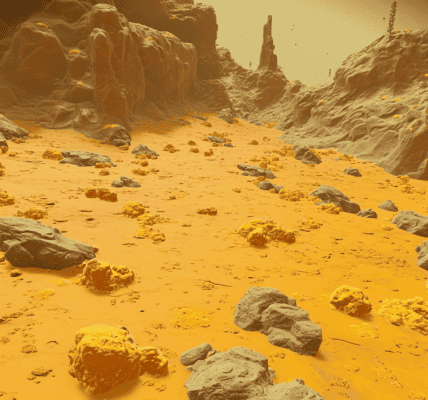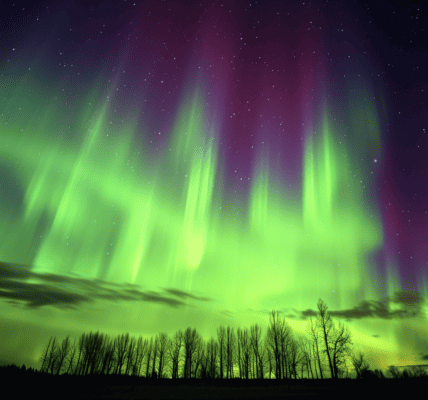The northern lights, also known as aurora borealis, are set to dazzle the night sky across several states in the United States, offering a rare opportunity for many to witness this stunning natural phenomenon. This celestial display is a result of solar activity that interacts with the Earth’s magnetic field, creating vibrant curtains of color that can light up the night sky.
Recently, the United Kingdom experienced a spectacular showing of the northern lights, with sightings reported as far south as Kent. This unusual occurrence has sparked interest in understanding the science behind the auroras and where they can be seen in the U.S. as the phenomenon is expected to continue into the weekend.
Understanding the Northern Lights
The northern lights occur when charged particles from the sun collide with atoms and molecules in the Earth’s atmosphere. These collisions excite the gases, causing them to emit light in various colors, predominantly green, pink, and purple. The phenomenon is typically observed in high-latitude regions near the Arctic and Antarctic Circles, such as Canada, Scandinavia, and parts of Alaska.
In the southern hemisphere, the aurora is referred to as aurora australis, or the southern lights. Both types of auroras are caused by similar processes involving solar wind and geomagnetic storms, which can be triggered by coronal mass ejections (CMEs) from the sun. During these rare solar events, the sun releases a significant amount of plasma that can travel towards Earth, resulting in geomagnetic storms that enhance auroral activity.
Forecast for Aurora Visibility in the U.S.
According to the Space Weather Prediction Center, a branch of the National Oceanic and Atmospheric Administration (NOAA), the northern lights are expected to be visible across large portions of North America, including several northern states. Areas in Minnesota, North Dakota, Washington, and Montana are among the best spots to catch a glimpse of this extraordinary light show.
The visibility of the auroras can be influenced by various factors, including solar activity levels and local weather conditions. Clear, dark skies away from city lights provide the best viewing conditions. As such, those hoping to witness the lights should seek locations with minimal light pollution and an unobstructed view of the northern horizon.
Optimal Locations for Viewing
In the United States, the northern lights are most commonly seen in states that lie closer to the Canadian border. Here are some prime locations for aurora watching:
- Minnesota: The Boundary Waters Canoe Area Wilderness is a popular destination for viewing the aurora due to its remote location and dark skies.
- North Dakota: Theodore Roosevelt National Park offers excellent opportunities for aurora viewing, especially during the fall and winter months.
- Montana: Glacier National Park is another stunning location where visitors can enjoy the northern lights against a backdrop of majestic mountains.
- Washington: The northern parts of Washington, particularly around the San Juan Islands, can also provide good viewing opportunities.
What to Expect
Those planning to watch the northern lights should prepare for varying intensity levels. During strong geomagnetic storms, the auroras can be visible at lower latitudes than usual, potentially allowing more people to experience this breathtaking event. The colors of the auroras can change based on the type of gas involved in the collisions; for example, oxygen at high altitudes can produce red and green hues, while nitrogen can create purples and blues.
While the northern lights can be unpredictable, enthusiasts are encouraged to stay updated on solar activity forecasts and geomagnetic storm predictions. Websites and apps dedicated to aurora tracking can provide real-time updates on the likelihood of sightings in specific areas.
Preparing for a Night of Aurora Watching
To maximize the chances of witnessing the northern lights, consider the following tips:
- Dress Warmly: Nights can be chilly, especially in northern states, so wear layers to stay comfortable.
- Bring Equipment: A good camera with a tripod can help capture the beauty of the auroras. Apps that track star positions can assist in finding the best angles.
- Be Patient: Auroras can appear and disappear quickly, so it’s essential to be patient and ready to enjoy the show.
- Stay Informed: Check local forecasts and aurora alerts to know the best times for viewing.
The northern lights are a captivating display of nature’s beauty, and the upcoming visibility across parts of the U.S. presents an exciting opportunity for many to witness this awe-inspiring event. Whether you’re a seasoned aurora watcher or experiencing it for the first time, the experience is sure to be memorable.
As the night sky lights up with vibrant colors, it serves as a reminder of the wonders of our universe and the ongoing interactions between the sun and our planet. So, gather your friends or family, head to a dark location, and prepare to be amazed by the celestial dance of the northern lights.





